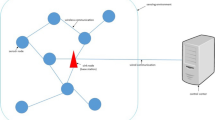Abstract
With the rapid development of society around the world, the population of cities such as Beijing and Shanghai has increased dramatically, and large social activities have been increasing. Safeguarding the legitimate rights and interests of citizens and strengthening public safety is one of the most important problems. Therefore, it is a very important research topic to study the aggregation phenomenon and the evacuation characteristics of the public places, to explore the reasonable group organization and evacuation mode, and to find ways and means to reduce the risk of accidents. When a sudden event occurs in a public place, the crowd is evacuated using the particle swarm algorithm. In addition, the shortcomings of the traditional particle swarm optimization are improved, and the influence of obstacle on individual evacuation path selection is fully considered. Finally, the thermodynamic diagram is used to simulate the model, and the feasibility of the model is verified.
Access this chapter
Tax calculation will be finalised at checkout
Purchases are for personal use only
Similar content being viewed by others
References
In recent years, a list of vicious stampede events. http://china.caixin.com/2015-01-01/100770129.html
Cai, C., Niu, Z.: Modeling and simulation of mixed traffic flow at intersection. J. North China Instit. Aerosp. Technol. 19(2), 18–20 (2009)
Chen, T., Ying, Z., Shen, S.: Evacuation simulation and analysis of social force model influenced by relative velocity. J. Prog. Nat. Sci. 16(12), 1606–1612 (2006)
Chui, X., Li, Q., Chen, J., Chen, C.: Research on evacuation model of public places based on multi-agent technology. J. Syst. Simul. 20(4), 1006–1010 (2008)
Zeng, W., Chen, P., Nakamura, H., et al.: Application of social force model to pedestrian behavior analysis at signalized crosswalk. J. Transp. Res. Part C Emerg. Technol. 40(1), 143–159 (2014)
Hu, J., You, L.: Cellular automata model for three-dimensional space pedestrian evacuation. J. Phys. 63(8), 65–74 (2014)
Izquierdo, J., Montalvo, I., Perez, T., et al.: Forcasting pedestrian evacuation times by using swarm intelligence. J. Phys. A 388(7), 1213–1220 (2009)
Zheng, Y., Chen, J., Wei, J., et al.: Modeling of pedestrian evacuation based on the particle swarm optimization algorithm. J. Phys. A 391(17), 4225–4233 (2012)
Rada-Vilela, J., Zhang, M., Seall, W.: A performance study on synchronicity and neighborhood size in particle swarm optimization. J. Soft Comput. 17(6), 1019–1030 (2013)
Chen, Y., Lin, Y.: Controlling the movement of crowds in computer graphics by using the mechanism of particle swarm optimization. J. Appl. Soft Comput. 9(3), 1170–1176 (2009)
Thermodynamic diagram. http://baike.baidu.com/link?url=N_GvhSAIL4a41RKMA9fNT0a-yD4AK_NQa2-Y7smzbDUDAnnKE4eF9j_uOiiU5Q5jo52iwKkB0nrIqY2efxI–9P1qOSlVDz9geFzMkkU7EJDfmiwGovncN8Y3jeMAm_w
Acknowledgements
This research reported herein was supported by the NSFC of China under Grant No. 71571091.
Author information
Authors and Affiliations
Corresponding authors
Editor information
Editors and Affiliations
Rights and permissions
Copyright information
© 2018 Springer International Publishing AG
About this paper
Cite this paper
Li, D., Chen, X., Sun, Q. (2018). The Study of Population Evacuation Problems. In: Arezes, P. (eds) Advances in Safety Management and Human Factors. AHFE 2017. Advances in Intelligent Systems and Computing, vol 604. Springer, Cham. https://doi.org/10.1007/978-3-319-60525-8_64
Download citation
DOI: https://doi.org/10.1007/978-3-319-60525-8_64
Published:
Publisher Name: Springer, Cham
Print ISBN: 978-3-319-60524-1
Online ISBN: 978-3-319-60525-8
eBook Packages: EngineeringEngineering (R0)




